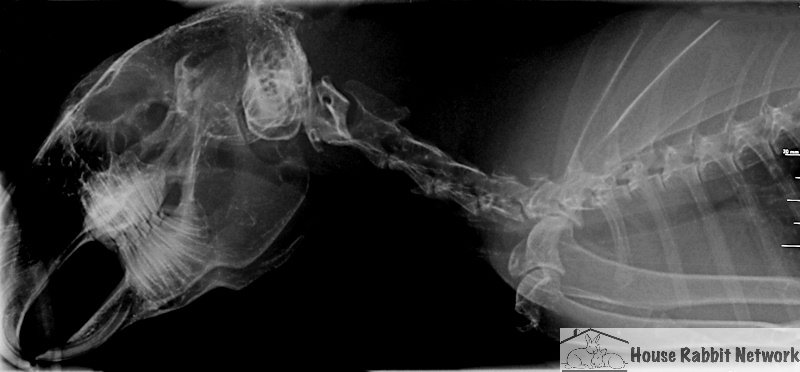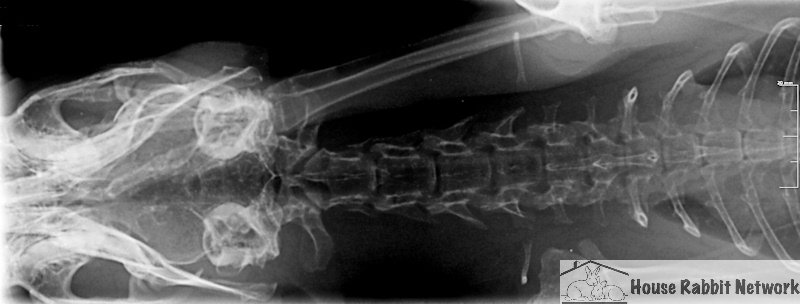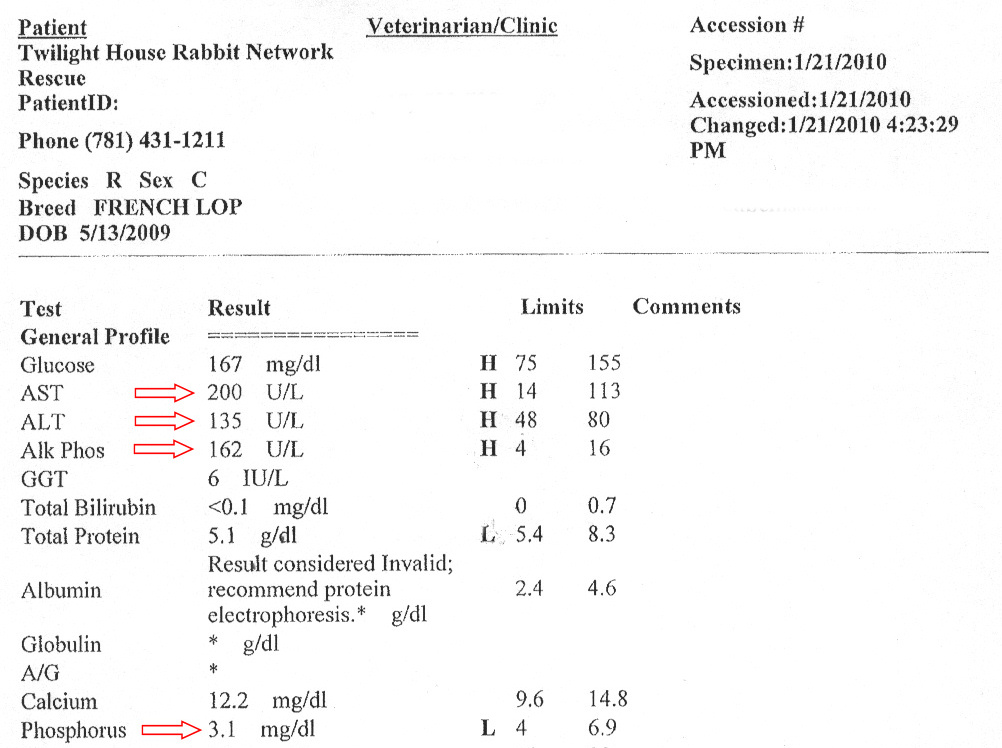“Head-down syndrome” or “Twilight's
syndrome"
Was it hepatic encephalothy ?
Suzanne Trayhan, with her
permission
|
Twilight is a sweet young mini-lop who became
seriously ill on Jan 20, 2010. His condition has been posted on many lists,
and people are asking how he is doing would like more details on his story.
To make it easier for people to follow, I will be placing all information on
him here. I would also like to send a HUGE thank you to everyone who has
shown interest in him and has offered tips/suggestions.
Basic information: -
Born May 2009; -
Came into HRN foster care July 2009; -
Appeared to be completely healthy; -
White mini-lop; -
neutered Sep 8 2009; -
Weighs 6 pounds / 2.7 kilos. Here
is some video of a healthy Twilight taken approximately 6 weeks before his
illness.
Jan 20, 2010 First thing in the morning I went
downstairs to feed the foster rabbits, and noticed that Twilight was having a
problem lifting his head. The previous night he appeared healthy, with no
obvious problems. I took him to the vet, who didn't know what was wrong with
him. We started him on enrofloxacine (Baytril),
fenbendazole (Panacur), puralube
(sterile eye lubricant/tears) and meloxicam (Metacam). He is also receiving
sub-q fluids and critical care. Here is some video of his condition.
Please note - he was only on the floor
for filming to video. He has plenty of towels in his cage to make moving
around easier.
Jan 21 He made it through the night, and appeared
slightly worse. I took him into Angell Memorial Hospital in Boston where he
could see specialists. He was observed by both Dr DeCubellis
(exotics specialist) and Dr Farabaugh
(neurologist). He had a fairly lengthy exam, along with radiographs (skull,
neck, spine):
A complete blood test (CBC and blood
chemistry profile) was also done. The results show elevated liver enzyme
values and low phosphorus.
It is important to note that this is very localized to the back of the neck area. All of his
legs are strong and seem to have full movement. The neck area was hypersensitive;
sometimes it appeared to be twitching. There is no nystagmus.
He has an excellent appetite but is having trouble positioning himself to
eat. Initially they thought that he tore a ligament in the back of his neck,
but later ruled that out. Also no signs of trauma. No swelling, redness,
nothing. Radiographs and blood work came back normal. Many different ideas
were bounced around, but the doctors were stumped. Some random comments- this is NOT head tilt. It
doesn't appear to be the parasite Encephalitozoon cuniculi, but no one
feels it can be ruled out completely. No evidence of a spider bite. Many
things people have suggested can easily be ruled out because he has good
strength with his legs. There is no point of localization. He lives in a cage
by himself; we don't believe he had access to any strange plants or poisonous
objects. Food is fresh and had no signs of mold. He doesn't lean to either
side, and has twisted his head to rest in both directions. Radiographs were
taken at a couple of angles. A couple of people have suggested myastenia gravis – a neuromuscular disease
characterized by muscle weakness, which isn't a first choice but hasn't been
ruled out either. They ruled out an electrolyte imbalance. Jan 22 In
the morning he seemed a tiny bit worse. I gave him his critical care, which
he rapidly eats, his fluids and meds. During the day he seemed stable. Late at
night, it seems like he might be slightly improved. I spend a lot of time
cradling him like a baby on his back. Jan 23
Twilight has definitely improved. He can now lift his head up for
short periods of time and is eating fairly well on his own. He can even go in
and out of his litter box. Fingers crossed that he continues. Here is updated
video. Yes, I woke him up, but needed to do fluids and meds on him.
We are discussing alternative care-
acupuncture, chiropractic.
Jan 24
Twilight continues to get stronger. He is now keeping his head up for
a fair amount of time. He is moving around his cage and eating well. He is more
active and is looking for attention. Jan 25 Twilight is getting
stronger each day and is looking pretty good today. We still don't know what
happened to him but are thrilled that he has improved so much. Here is more
video of him.
Almost three years later, you would never know Twilight had been seriously
ill. He is a happy, healthy, bratty bunny.
Since, more rabbits have suffered from
“head-down syndrome”. Another
three rabbits were all from the Lemspter
rescue (Oct 8 2011). I don't know if that means anything or if it
is a coincidence but since this syndrome is so rare I think it is
worth noting. The Lempster rescue is a large scale rescue of about 90 rabbits we pulled
that were living in a shed in New Hampshire. These rabbits have been
given fenbendazole (Panacur) and meloxicam
(Metacam): The
three Lempster buns were: ·
Franklin – who was a young male about 12 weeks
old and came down with it the day after the rescue. Franklin was on
antibiotics for a couple of days, but seemed to really show improvement once
we started him on fenbendazole (Panacur). He
recovered fairly quickly- within a week he was close to normal. ·
Midnight – the results of the blood tests (CBC and chemistry profile)
show the same abnormalities as observed with Twilight: elevated values for
liver enzymes and low phosphorus, which are related to fulminant liver
failure. ·
Lewis is the third bun. The difference here is he was never in that shed.
Rather he was from a litter born in our foster care from one of the pregnant Lempster buns we rescued. He came down with it just this
past Sept 23 at about 10-11 months old. Lewis’ recovery was slightly slower,
I would say 9-10 days. A few more rabbits have been affected
by this syndrome, and recovered, but there has been no follow-up. |
||||||||
Many thanks also to Bonnie Salt
e-mail: info@medirabbit.com







